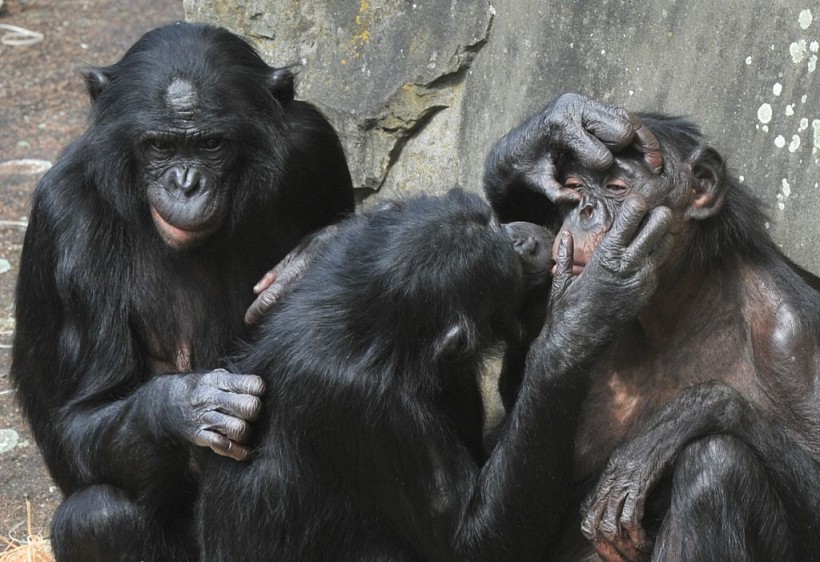A new study published in the journal Science revealef that bonobos, our closest living relatives, are capable of cooperating with individuals from other groups, even forming alliances against sexual aggressors.
The findings offered clues into how early human societies might have evolved from small kin-based groups to larger and more complex ones.
Bonobos: The Peaceful Apes
 (Photo : GEORGES GOBET/AFP via Getty Images)
(Photo : GEORGES GOBET/AFP via Getty Images)

Bonobos (Pan paniscus) are one of the two species of chimpanzees, the other being the common chimpanzee (Pan troglodytes).
Both are genetically very similar to humans, sharing about 98% of our DNA.
However, while common chimpanzees are known for their aggressive and violent behavior towards outsiders, bonobos are more peaceful and tolerant.
Bonobos live only in the remote forests of the Democratic Republic of the Congo, where they face threats from habitat loss, hunting, and civil war. They are classified as endangered by the International Union for Conservation of Nature (IUCN).
Bonobo societies are female-led, making them the only matriarchal great ape species.
Scientists have documented them in both zoos and in the wild, openly and willingly sharing food and shelter with bonobos unfamiliar to them.
They also use sex as a way of resolving conflicts and maintaining social bonds, earning them the nickname of "the hippies of the animal kingdom".
These primates are highly intelligent and have been shown to communicate with gestures, facial expressions, and vocalizations. Some bonobos have even learned to use human language and symbols in captivity.
Also Read: Bonobos in the Wild Capable of Forming Strategic Alliances With Other Groups
Cooperation Beyond Kinship
The new study, led by Liran Samuni of the German Primate Center in Gottingen and Martin Surbeck of Harvard University, is the first to examine the interactions between different bonobo groups in the wild.
The researchers spent two years following two small bonobo groups of 11 and 20 adults respectively, at the Kokolopori Bonobo Reserve in the Democratic Republic of the Congo.
They observed that the bonobos spent 20% of their total time together, engaging in various cooperative behaviors, such as grooming, food sharing, traveling, and resting2.
The researchers also found that the cooperation between the groups was driven largely by a select few individuals who were more helpful within their own group.
These "pro-social" bonobos tended to connect with similar bonobos from the other group, creating a system of mutual benefit, or "reciprocal altruism".
For example, the researchers witnessed a case where a female bonobo from one group groomed a male bonobo from another group, and later received food from him.
Another interesting finding was that female bonobos formed coalitions with females from other groups to protect themselves from sexual aggression by males.
The researchers recorded an incident where a male bonobo tried to force a female bonobo from another group to mate with him, but was chased away by a group of females from both groups.
This suggests that female bonobos use cooperation as a strategy to increase their reproductive autonomy and reduce male dominance.
A Window into Our Past
The study provides new insights into the evolutionary origins of human cooperation, which is considered a key factor for the success of our species.
Human society is founded on our ability to cooperate with others beyond our immediate family and social groups, in everything from trade and politics to culture and religion.
However, the evolutionary roots of this trait are still unclear. Some scientists have argued that hostility against outsiders is innate to human nature, and that we have overcome it by inventing new social norms and institutions.
Others have suggested that cooperation with strangers is an ancient and adaptive trait that emerged in response to ecological and social challenges.
The new study supports the latter view, by showing that bonobos, our closest living relatives, also cooperate with outsiders, in ways that are similar to humans.
The researchers argued that studying bonobos offers a "window into our past," possibly revealing how our own ancestors began to expand their social networks and collaborate with others for mutual benefit.
They also proposed that bonobos can serve as a model for understanding the role of female empowerment and sexual equality in human evolution, as these factors may have facilitated cooperation and reduced violence among early humans.
The study also has implications for the conservation of bonobos, as it highlights their unique and complex social behavior, which is threatened by human activities.
The researchers hoped that their findings will raise awareness and support for the protection of bonobos and their habitat, as well as the local communities that coexist with them.
They also plan to continue their research on bonobo cooperation, by exploring the genetic, hormonal, and neural mechanisms that underlie it, and by comparing it with the cooperation of other primates, such as chimpanzees and gorillas.
Related article: Attractive Females Dominate the Social Circle: Bonobo Study
© 2024 NatureWorldNews.com All rights reserved. Do not reproduce without permission.



![Roundworms with Short Memories 'Stop Forgetting' When Frozen or Given Lithium [Study]](https://1471793142.rsc.cdn77.org/data/thumbs/full/70295/280/157/50/40/roundworms-with-short-memories-stop-forgetting-when-frozen-or-given-lithium-study.jpg)

